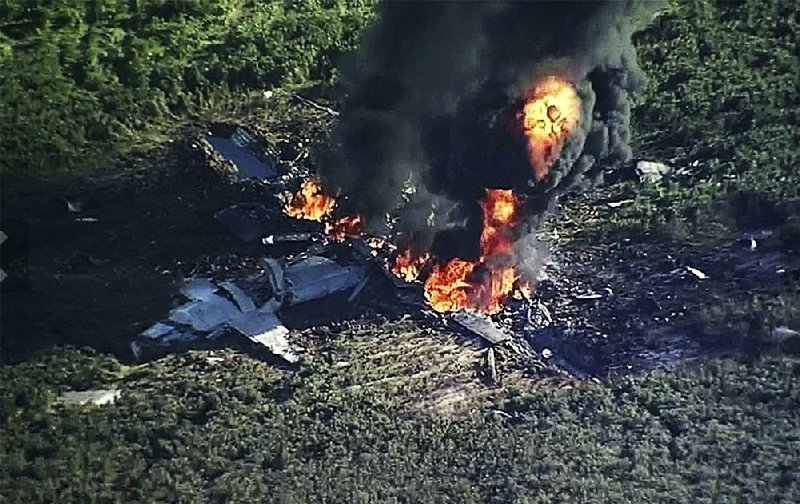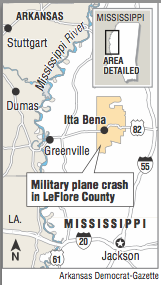Military investigators picked through the charred wreckage of a Marine Corps cargo plane Tuesday, hunting for clues for why the plane spiraled out of the sky in western Mississippi, killing 15 Marines and a Navy sailor, a Marine statement said.
The probe into Monday's crash of the KC-130 aircraft that was flying from Marine Corps Air Station Cherry Point, N.C., is ongoing, the Marine statement said. The aircraft, used for refueling and carrying cargo and troops, was carrying members of an elite special operations unit cross-country for training in Arizona.
Equipment onboard the aircraft included small arms and ammunition, another Marine statement said. Bomb disposal experts were sent to the crash scene as a precaution.
FBI agents joined the military investigators, Marine Maj. Andrew Aranda told reporters, adding that no foul play was suspected in the crash.
"They are looking at the debris and will be collecting information off of that to figure out what happened," Aranda said. The county coroner, meanwhile, provided body bags to remove the dead.
The names of those killed were not immediately made public pending notification of family members, the Marine statement said.
The crash happened outside the small town of Itta Bena, about 85 miles north of the state capital of Jackson. Bodies were found more than a mile from the plane.
It was the deadliest Marine Corps air disaster since 2005, when a transport helicopter went down during a sandstorm in Iraq, killing 30 Marines and a sailor.
Mississippi Emergency Management Agency Director Lee Smithson told the Clarion-Ledger that the aircraft crashed on the Leflore-Sunflower county line in a rural stretch of woods and fields with dense underbrush.
The plane was based at Stewart Air National Guard Base in Newburgh, N.Y., and officials said some of those killed were from the base. Several bouquets were left at the main gate of the base, which was closed to reporters.
Six of the Marines and the sailor were from an elite Marine Raider battalion at Camp Lejeune, N.C., the Marine Corps said. It said the seven and their equipment were headed for predeployment training at Yuma, Ariz.
The Marine Raiders are a special operations force that is part of the global fight against terrorism. They carry out raids against insurgents and terrorists, conduct deep reconnaissance and train foreign militaries.
Andy Jones said he was working on his family's catfish farm in Mississippi just before 4 p.m. when he heard a boom and looked up to see the plane corkscrewing downward with one engine smoking.
"You looked up, and you saw the plane twirling around," he said. "It was spinning down."
He said the plane hit the ground behind some trees in a soybean field, and by the time he and others reached the crash site, fires were burning too intensely to approach the wreckage. The force of the crash nearly flattened the plane, Jones said.
"Beans are about waist-high, and there wasn't much sticking out above the beans," he said.
Other witnesses said they heard low, rumbling explosions when the plane was still high in the sky, saw the aircraft spiraling toward the flat, green landscape and spotted an apparently empty parachute floating toward the earth.
Pictures posted on Facebook and published by the Clarion-Ledger showed thick black smoke coming from a field. The debris field appeared to cover a large area.
In a statement Tuesday morning, the commandant of the Marine Corps, Gen. Robert Neller, pledged a thorough investigation of the crash.
"On behalf of the entire Marine Corps, I want to express my deepest condolences to the families of those killed in the aircraft mishap yesterday afternoon in Mississippi," Neller said.
The KC-130 is a four-engine propeller-driven aircraft that is a variant of the Cold War-era C-130 Hercules. The plane can be configured to refuel aircraft in midair or equipment on the ground. It can also haul troops and equipment, and in some cases carry an array of weapons.
Information for this article was contributed by Thomas Gibbons-Neff, Brian Murphy, Jeff Amy and Dan Lamothe of The Washington Post; and by Rogelio V. Solis and Emily Wagster Pettus of The Associated Press.
A Section on 07/12/2017

